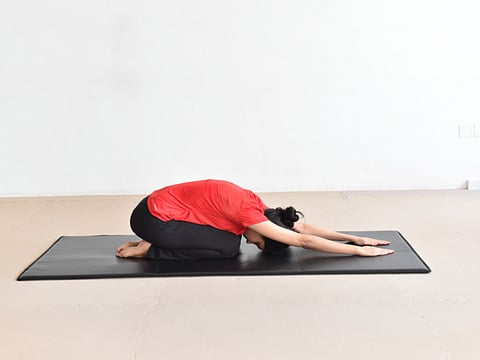Shashankasana: simple posture with multiple benefits
Stretch the back to relieve back muscles, tone pelvic muscles and alleviate disorders of both male and female reproductive organs

Shashankasana is also known as the pose of the moon or the hare pose. ‘Shashank’ is a Sankrit word which means moon. The moon symbolises peace and calm; it emits soothing and tranquilising vibrations. Shashankasana has a similar calming and cooling effect on an individual. At the same time, it is the position frequently adopted by hares and rabbits.
Benefits
This is a simple asana which holds multiple benefits for the body and mind.
- It stretches the back muscles and separates the individual vertebrae, releasing pressure on the discs. Often nerve connections emanating from the spinal cord are squeezed by these discs, giving rise to various forms of backache. This posture helps to relieve this problem and encourages the discs to resume their correct position.
- It also regulates the functioning of the adrenal glands.
- It tones the pelvic muscles and the sciatic nerves and is beneficial for women who have an underdeveloped pelvis.
- It helps to alleviate disorders of both the male and female reproductive organs.
- Regular practise relieves constipation.
- It helps eliminate anger and has a cooling effect on the brain.
Method
To sit in vajrasana (thunderbolt pose) kneel on the floor. Bring the big toes together and separate the heels. Lower the buttocks onto the inside surface of the feet with the heels touching the sides of the hips. Place the hands on the thighs. The back and head should be straight but not tense. Avoid excessive backward arching of the spine. Close the eyes and relax, keeping the spine and head straight.
While inhaling, raise the arms above the head, keeping them straight and shoulder width apart. Exhale slowly and bend the trunk forward from the hips, keeping the arms and head straight and in line with the trunk. At the end of the movement, the hands and forehead should rest on the floor.
Bend the arms slightly so that they are fully relaxed and let the elbows rest on the floor. Retain the breath for up to 5 seconds in the final position. Then, simultaneously inhale and slowly raise the arms and trunk to the vertical position. Keep the arms and head in line with the trunk. Breathe out again while lowering the arms to the knees. This is one round. Practise three to five rounds.
Increase the duration in the final position for at least three minutes while you breathe normally. To calm anger and frayed nerves increase the time to 10 minutes, breathing normally.
Variation
Sit in vajrasana. Make a fist with the thumb pressing against the edge of the little finger. Place the fists at the lower abdomen. Inhale and then, while exhaling, slowly bend forward until the forehead touches the floor. The fists will exert pressure on the lower abdominal organs. Retain the breath in the final position for a comfortable duration. Inhale while raising the trunk and head. Practice 2 to 3 rounds.
This variation massages and improves the efficiency of the intestines and digestive organs, relieving ailments such as constipation and excessive flatulence in addition to the benefits derived from the basic form of the practice. This is an excellent practice for diabetics.
Note: Shashankasana is not to be performed by people with very high blood pressure, slipped disc or those who suffer from vertigo. It should also be avoided in case of severe knee and ankle problems where excessive stretching of these joints may be painful.
Practice of the weekBegin with simple joint rotation in order to loosen up the body – neck, shoulders, wrist, hip, knees and ankles.
Titliasana
Vajrasana
Shanshankasana
Matsya Kridasana
Next week: Yoga techniques for healthy appetite
— This is an interactive series, in which we will bring you practical tips on daily living, inspired by the vision of yoga. Write in to tabloid@gulfnews.com with your questions and doubts regarding enhancing your lifestyle through yoga. For more information, call 800-YOGA (9642) or log on to artisticyoga.com
Sign up for the Daily Briefing
Get the latest news and updates straight to your inbox



